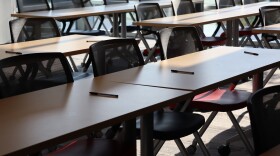The San Diego Zoo Wildlife Alliance is joining a world-wide effort to preserve species diversity by entering into a partnership with the International Union for the Conservation of Nature (IUNC).
The group supports conservation at the nation’s zoos, aquariums, and botanical gardens.
The local institution focuses on sharing knowledge developed, while caring for genetic material in the Alliance’s Frozen Zoo.
The repository contains cells from nearly 10,900 individual animals, and it is seen as a critical resource to help threatened and endangered species.
“The black-footed ferret clone is in here,” said Marlys Houck, the curator of Frozen Zoo as she lifted a stack of samples out of one of the super cooled stainless steel tanks.
The team uses liquid nitrogen to keep the samples frozen, and a cloud of super-cooled air spills over the lip of the tanks when they are opened.
“So each of these boxes holds 100 vials,” Houck said.
And each vial holds cells from a distinct animal.
There are more animals represented inside the Frozen Zoo than living on the grounds of the San Diego Zoo and Safari Park.
The collection contains many endangered species and three species that are extinct.
The Frozen Zoo also includes cell samples from 12 northern white rhinos. There are currently only two of the animals left alive and both are older females past their breeding age.
The collection is the most diverse of its kind in the world. A frozen sample of the critically endangered Przewalski’s horse stored here, actually led to the birth of a clone that now lives at the Safari Park.
Researchers hope to acclimate the clone to a small herd in the Safari Park so the animal’s genes can be reintroduced to the living population. That would greatly enhance the species’ genetic diversity.
“It’s huge because it shows that the technology works,” said Barbara Durrant, the director of Reproductive Sciences at the San Diego Zoo Wildlife Alliance. “We can actually recreate animals from the frozen zoo.”
The animal samples and a growing collection of seeds and frozen plants are part of the new Center for Species Survival: Biodiversity Banking in San Diego.
These efforts have an important role to play according to The International Union for the Conservation of Nature (IUNC). The group’s Kira Milehamn said efforts need to be coordinated and strategic.
“Whether we’re talking about saving species through cryo-preservation and biobanking, managing populations that are living in human care or out in the field working in situ, we all need to be working together,” Milehamn said. “Whether we’re a government, NGO, a zoo, aquarium or botanic garden expert, or a scientist out there on the ground in the field.”
The IUNC said the rate of extinction is alarming, claiming nearly three species an hour.
Local officials call the partnership a crucial step for conservation outside of San Diego.
“We talk a lot about conservation at its heart, starting with people. And it has to start with people so that it can grow,” said Paul Baribault, executive director of the San Diego Zoo Wildlife Alliance. “Build alliances. Build partnerships around the globe so we can achieve more together.”








